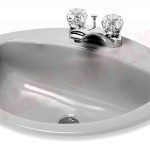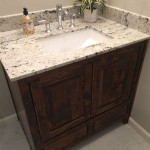The Allure and Practicality of Vertical Rectangle Undermount Bathroom Sinks
The bathroom sink, often overlooked as a purely functional fixture, plays a significant role in the overall aesthetic and usability of a bathroom. Among the myriad of sink styles available, the vertical rectangle undermount bathroom sink has gained considerable popularity due to its modern appeal, space-saving design, and ease of cleaning. This article delves into the characteristics, advantages, installation considerations, and maintenance tips associated with vertical rectangle undermount bathroom sinks, providing a comprehensive overview of this increasingly sought-after bathroom design element.
An undermount sink, by definition, is installed beneath the countertop, creating a seamless transition between the sink basin and the surrounding surface. This installation method offers a clean, minimalist look and eliminates the lip that can accumulate dirt and grime in overmount sinks. When combined with the vertical rectangular shape, the undermount installation enhances the sink's geometric design, resulting in a contemporary and sophisticated aesthetic. The vertical orientation, characterized by its taller rather than wider profile, can be particularly advantageous in smaller bathrooms where maximizing counter space is paramount.
Space Optimization and Design Versatility
One of the primary advantages of a vertical rectangle undermount bathroom sink lies in its efficient use of space. In bathrooms where counter space is limited, the vertical orientation of the sink allows for a deeper basin without compromising the available countertop area. This is particularly useful in powder rooms or smaller guest bathrooms where every inch counts. By extending vertically rather than horizontally, homeowners can enjoy a generously sized sink without sacrificing valuable space for toiletries, decorative items, or other bathroom essentials.
Furthermore, the rectangular shape lends itself well to a modern and minimalist design aesthetic. Its clean lines and sharp angles create a sense of order and sophistication, seamlessly integrating with contemporary bathroom fixtures and décor. The vertical rectangle shape balances perfectly with horizontal elements within the bathroom, offering a great design balance. The simplicity of the design also makes it versatile, coordinating well with a variety of countertop materials, including granite, quartz, marble, and solid surface options. The absence of a visible rim around the sink allows the countertop material to take center stage, showcasing its natural beauty and texture.
Beyond its space-saving and aesthetic benefits, the vertical rectangle undermount sink also offers flexibility in terms of faucet placement. Depending on the countertop layout and plumbing configuration, faucets can be mounted directly on the countertop, on the wall above the sink, or even as part of a freestanding fixture. This versatility allows for customization and personalization, enabling homeowners to create a bathroom design that reflects their individual style and preferences. The clean lines of the sink make it suitable for a variety of faucet styles, from sleek single-lever designs to more traditional cross-handle models.
The design versatility extends to the choice of materials as well. While vitreous china and porcelain are common materials for bathroom sinks, vertical rectangle undermount sinks are also available in stainless steel, cast iron, and even stone. Each material offers its own unique set of advantages and disadvantages in terms of durability, maintenance, and aesthetic appeal. For example, stainless steel is known for its durability and resistance to staining, while cast iron offers a classic look and exceptional heat retention. Choosing the right material is crucial for ensuring the sink's longevity and suitability for the specific bathroom environment.
Installation Considerations and Best Practices
Proper installation is paramount to ensure the longevity and functionality of a vertical rectangle undermount bathroom sink. Unlike drop-in or vessel sinks, undermount sinks require precise cutting and sealing of the countertop to create a watertight and visually appealing installation. The process typically involves creating a template of the sink’s outline, accurately transferring the template to the countertop, and carefully cutting the opening using specialized tools. Professional installation is highly recommended, especially for countertops made of delicate materials like marble or granite.
Before commencing the installation, it is essential to ensure that the countertop is adequately supported and that the plumbing connections are readily accessible. The weight of the sink, when filled with water, can exert significant stress on the countertop, necessitating proper reinforcement. Furthermore, the drain and water supply lines must be properly aligned and connected to prevent leaks and ensure efficient drainage. A qualified plumber can assess the existing plumbing infrastructure and make any necessary modifications to accommodate the new sink.
The installation process also involves applying a sealant between the sink and the countertop to create a watertight barrier. Silicone sealant is a common choice due to its flexibility and resistance to moisture. The sealant should be applied evenly and smoothly to prevent leaks and ensure a clean and professional finish. Excess sealant should be carefully removed to avoid unsightly residue. The quality of the sealant and the precision of its application are critical factors in preventing water damage and prolonging the life of the sink and countertop.
Once the sink is securely mounted and the plumbing connections are completed, it is important to test the installation for leaks. Run water into the sink and carefully inspect the drain and water supply lines for any signs of leakage. If leaks are detected, immediately turn off the water supply and tighten the connections or reapply sealant as needed. It is also advisable to check the sink’s alignment with the countertop to ensure that it is perfectly level and that there are no gaps or uneven edges.
Maintaining the Beauty and Functionality
Maintaining a vertical rectangle undermount bathroom sink requires regular cleaning and preventative measures to ensure its long-term beauty and functionality. The smooth, seamless surface of an undermount sink simplifies cleaning compared to other sink styles. However, it is still essential to regularly wipe down the sink with a soft cloth and mild detergent to remove soap scum, water spots, and other debris. Abrasive cleaners and harsh chemicals should be avoided, as they can damage the sink’s surface and diminish its luster.
Hard water stains can be a common problem, particularly in areas with high mineral content in the water supply. To remove hard water stains, a solution of vinegar and water can be applied to the affected areas. Allow the solution to sit for a few minutes before scrubbing gently with a soft brush or sponge. Rinse thoroughly with water and dry with a clean cloth. For stubborn stains, a commercially available limescale remover can be used, following the manufacturer’s instructions carefully.
The drain is another area that requires regular maintenance. Over time, hair, soap scum, and other debris can accumulate in the drain, leading to clogs and slow drainage. To prevent clogs, it is advisable to use a drain strainer to catch hair and other large particles. Periodically, the drain should be flushed with hot water to remove any accumulated debris. For more stubborn clogs, a plunger or drain snake can be used. Chemical drain cleaners should be used sparingly, as they can damage the plumbing pipes and pose environmental hazards.
In addition to regular cleaning, preventative measures can also help to prolong the life of the sink. Avoid dropping heavy objects into the sink, as this can cause cracks or chips. Wipe up spills immediately to prevent staining. Periodically inspect the sealant between the sink and the countertop and reapply as needed to prevent water damage. By following these simple maintenance tips, homeowners can ensure that their vertical rectangle undermount bathroom sink remains a beautiful and functional addition to their bathroom for years to come. The understated, modern aesthetic of these sinks, combined with their practical advantages, solidify their status as a popular and desirable choice for contemporary bathroom design.

Verticyl Undermount Rectangular Sink K 8189 Kohler

Kohler Verticyl 19 13 16 In Rectangle Undermount Bathroom Sink White With Overflow Drain K 2882 0 The Home Depot

Kohler Verticyl 19 13 16 In Rectangle Undermount Bathroom Sink White With Overflow Drain K 2882 0 The Home Depot

Kohler Verticyl 19 13 16 In Rectangle Undermount Bathroom Sink White With Overflow Drain K 2882 0 The Home Depot

Kohler K 2882 Verticyl Rectangular Undermount Bathroom Sink Edelman Home

Verticyl Rectangle Undermount Bathroom Sink Wm Dyck Sons

Kohler Verticyl Rectangle White Undermount Rectangular Traditional Bathroom Sink 13 375 In X 17 125 The Sinks Department At Com

Kohler 2882 0 Verticyl Rectangle Undercounter Lav

Kohler Verticyl Rectangle Undermount Bathroom Sink 8189 58 Zoro

Kohler Verticyl White Undermount Rectangular Traditional Bathroom Sink 19 81 In X 15 625 The Sinks Department At Com
Related Posts







